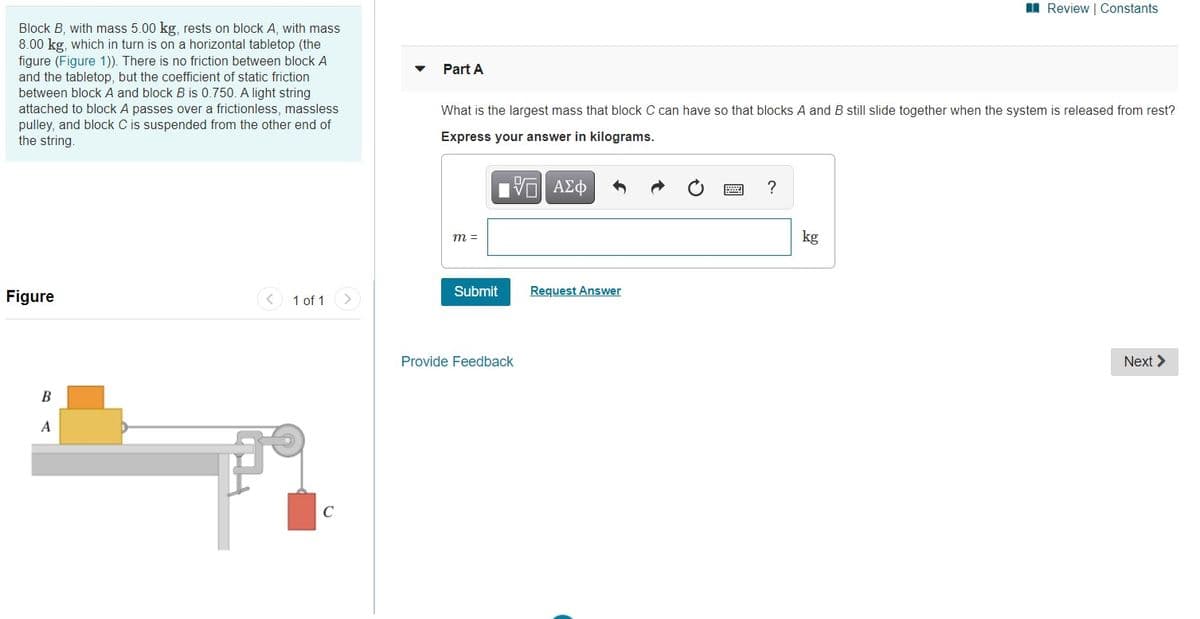Block B, with mass 5.00 kg, rests on block A, with mass 8.00 kg, which in turn is on a horizontal tabletop (the figure (Figure 1)). There is no friction between block A and the tabletop, but the coefficient of static friction between block A and block B is 0.750. A light string attached to block A passes over a frictionless, massless pulley, and block C is suspended from the other end of the string.
Block B, with mass 5.00 kg, rests on block A, with mass 8.00 kg, which in turn is on a horizontal tabletop (the figure (Figure 1)). There is no friction between block A and the tabletop, but the coefficient of static friction between block A and block B is 0.750. A light string attached to block A passes over a frictionless, massless pulley, and block C is suspended from the other end of the string.
University Physics Volume 1
18th Edition
ISBN:9781938168277
Author:William Moebs, Samuel J. Ling, Jeff Sanny
Publisher:William Moebs, Samuel J. Ling, Jeff Sanny
Chapter5: Newton's Law Of Motion
Section: Chapter Questions
Problem 52P: A brave but inadequate rugby player is being pushed backward by an opposing player who is exerting a...
Related questions
Topic Video
Question
100%

Transcribed Image Text:I Review | Constants
Block B, with mass 5.00 kg, rests on block A, with mass
8.00 kg, which in turn is on a horizontal tabletop (the
figure (Figure 1)). There is no friction between block A
and the tabletop, but the coefficient of static friction
between block A and block B is 0.750. A light string
Part A
attached to block A passes over a frictionless, massless
pulley, and block C is suspended from the other end of
the string.
What is the largest mass that block C can have so that blocks A and B still slide together when the system is released from rest?
Express your answer in kilograms.
kg
m =
Figure
1 of 1
Submit
Request Answer
>
Provide Feedback
Next >
B
A
C
Expert Solution
Step 1
Given,
m = 5kg
= 0.750
Trending now
This is a popular solution!
Step by step
Solved in 2 steps with 1 images

Knowledge Booster
Learn more about
Need a deep-dive on the concept behind this application? Look no further. Learn more about this topic, physics and related others by exploring similar questions and additional content below.Recommended textbooks for you

University Physics Volume 1
Physics
ISBN:
9781938168277
Author:
William Moebs, Samuel J. Ling, Jeff Sanny
Publisher:
OpenStax - Rice University

Glencoe Physics: Principles and Problems, Student…
Physics
ISBN:
9780078807213
Author:
Paul W. Zitzewitz
Publisher:
Glencoe/McGraw-Hill

College Physics
Physics
ISBN:
9781938168000
Author:
Paul Peter Urone, Roger Hinrichs
Publisher:
OpenStax College

University Physics Volume 1
Physics
ISBN:
9781938168277
Author:
William Moebs, Samuel J. Ling, Jeff Sanny
Publisher:
OpenStax - Rice University

Glencoe Physics: Principles and Problems, Student…
Physics
ISBN:
9780078807213
Author:
Paul W. Zitzewitz
Publisher:
Glencoe/McGraw-Hill

College Physics
Physics
ISBN:
9781938168000
Author:
Paul Peter Urone, Roger Hinrichs
Publisher:
OpenStax College


College Physics
Physics
ISBN:
9781305952300
Author:
Raymond A. Serway, Chris Vuille
Publisher:
Cengage Learning

Physics for Scientists and Engineers with Modern …
Physics
ISBN:
9781337553292
Author:
Raymond A. Serway, John W. Jewett
Publisher:
Cengage Learning